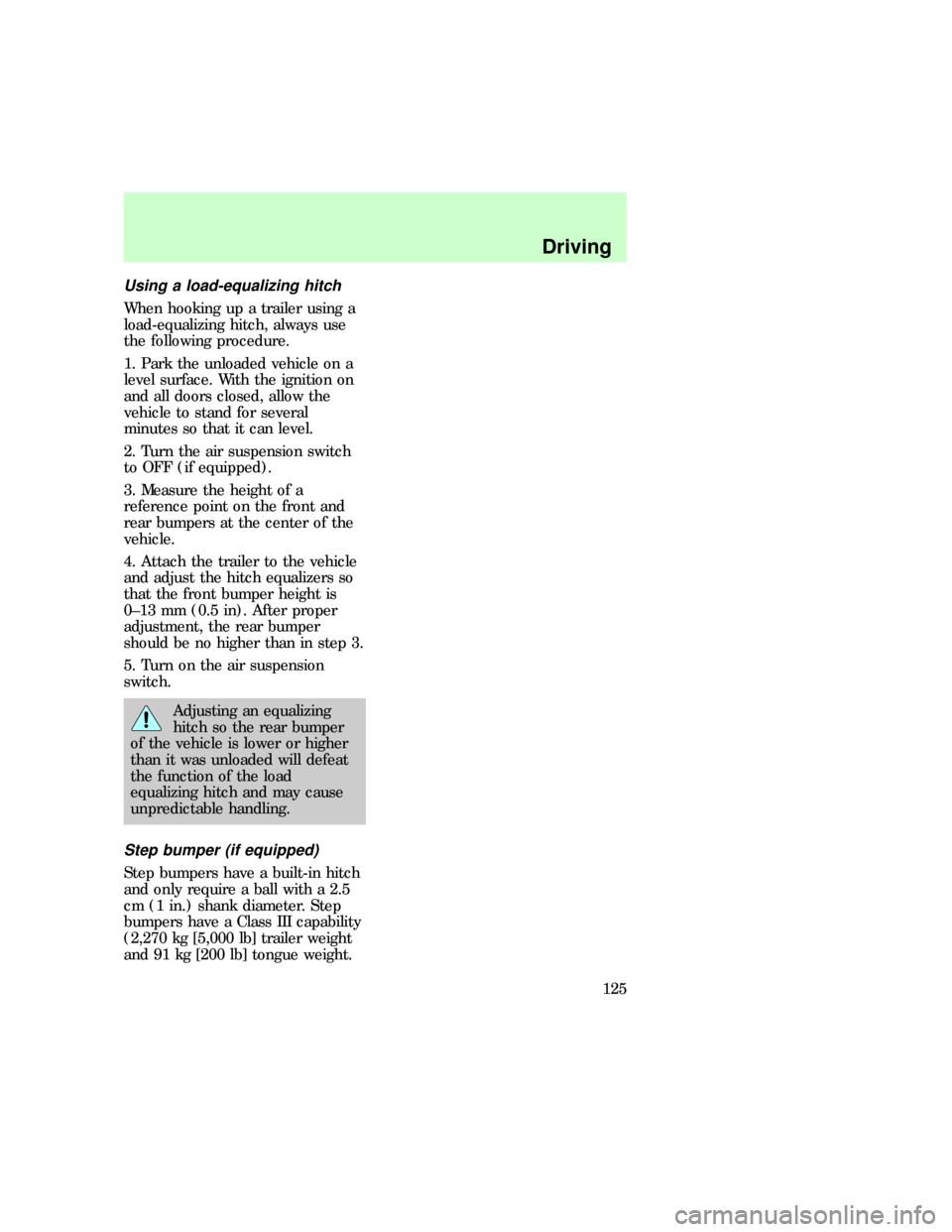Page 123 of 219
Do not exceed the GVWR
or the GAWR specified on
the Safety Compliance
Certification Label.
Towing trailers beyond the
maximum recommended
gross trailer weight could result
in engine damage,
transmission/axle damage,
structural damage, loss of
control, and personal injury.
Preparing to tow
Use the proper equipment for
towing a trailer, and make sure it
is properly attached to your
vehicle. See your dealer or a
reliable trailer dealer if you require
assistance.
Hitches
Do not use or install hitches that:
²clamp onto the vehicle bumper
²attach to the axle.
Underbody hitches are acceptable
if installed properly.
Distribute the load so that only 10
to 15% of the total is on the
tongue. Tie down the load so that
it does not shift and change the
weight on the hitch.
f12_preparing_tow
f12_hitches
Driving
124
Page 124 of 219

Using a load-equalizing hitch
When hooking up a trailer using a
load-equalizing hitch, always use
the following procedure.
1. Park the unloaded vehicle on a
level surface. With the ignition on
and all doors closed, allow the
vehicle to stand for several
minutes so that it can level.
2. Turn the air suspension switch
to OFF (if equipped).
3. Measure the height of a
reference point on the front and
rear bumpers at the center of the
vehicle.
4. Attach the trailer to the vehicle
and adjust the hitch equalizers so
that the front bumper height is
0±13 mm (0.5 in). After proper
adjustment, the rear bumper
should be no higher than in step 3.
5. Turn on the air suspension
switch.
Adjusting an equalizing
hitch so the rear bumper
of the vehicle is lower or higher
than it was unloaded will defeat
the function of the load
equalizing hitch and may cause
unpredictable handling.
Step bumper (if equipped)
Step bumpers have a built-in hitch
and only require a ball with a 2.5
cm (1 in.) shank diameter. Step
bumpers have a Class III capability
(2,270 kg [5,000 lb] trailer weight
and 91 kg [200 lb] tongue weight.
f12_step_bumper
Driving
125
Page 128 of 219
Exceeding these limits may allow
water to enter critical vehicle
components, adversely affecting
driveability, emissions and
reliability.
Servicing when towing
If you tow a trailer for long
distances, your vehicle will require
more frequent service intervals.
Refer to the ªService Guideº for
more information.
SNOWPLOWING
Ford recommends the following
specifications for low speed,
personal use snow removal:
²F-150 4WD long wheelbase or
F-250 4WD Regular Cab
²4.6L or 5.4L engine
²Super engine cooling
²Heavy duty front suspension
package
²Automatic transmission with
auxiliary automatic transmission
fluid cooling
²All-terrain tires
Do not install a snowplow and
plow with your vehicle until it has
been driven at least 800 km (500
miles).
Installing snowplow
Read the following instructions
before installing a snowplow:
²Front GAWR must not exceed
63% of the GVW. Add ballast
weight to the back of the
f12_service_towing
f12_snowplowing
f12_install_plow
Driving
129
Page 129 of 219

vehicle, if necessary. Refer to
the Safety Compliance
Certification Label to find Front
GAWR.
²The Front Axle Accessory
Reserve Capacity and the Total
Accessory Reserve Capacity
listed on the bottom right of the
Safety Compliance Certification
Label will determine whether or
not the addition of a snowplow
will overload your vehicle.
²The weight of the snowplow and
supporting components
distributed to the front axle
must not exceed the front
accessory reserve capacity.
²The total weight of the
snowplow and aftermarket
equipment must not exceed the
Total Accessory Reserve
Capacity.
²The weight of the installed
snowplow and aftermarket
equipment must not load the
vehicle beyond the GAWR and
GVWR listed on the Safety
Compliance Certification Label.
²Federal and most local
regulations require additional
exterior lamps for
snowplow-equipped vehicles.
Consult your dealer for
additional information.
²After installing a snowplow to
the vehicle, ensure the vehicle's
front toe alignment and front
ride height are within
specification (reset if required).
Driving
130